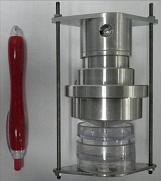Exposure to nanoparticles, a threat to the health of workers, is a problem all the developed countries are very concerned about. Now the Institute of Occupational Safety and Health, a unit of the Council of Labor Affairs, and Professor Tsai Chuen-Jinn from National Chiao Tung University have successfully developed a personal nanoparticle sampler that can be carried on the worker’s body and immediately measure the exposure to nanoparticles at work, and serve as a reference for the management of the risk of exposure to nanoparticles.
Recent research points out that nanoparticles, in comparison with larger suspended particles, are not so easy to destroy by the macrophages of the lungs and have a larger surface, which means that nanoparticles entering the human body will more easily interact with the epithelium cells of the lungs. Besides, depending on the shape, size and amount of suspended particles, inhaled nanoparticles might sediment in various organs of the body, and thus lead to damage of the respiratory tracts, the cardiovascular system, the central nervous system and the immune system.
In its “Current Intelligence Bulletin (CIB)”, the American National Institute for Occupational Safety and Health (NILOSH) pointed out that the recommended exposure limit (REL) of respirable TiO2 particles and nanoparticles is 1.5 resp. 0.1 mg/m3, but right now there is no appropriate personal nanoparticle sampler on the market which would be able to assess whether the concentration of nanoparticles in the workplace exceeds the REL value.
Although there has been a lot of concern about the risks nanoparticles pose to the human body, until recently there was no personal sampling device for measuring nanoparticle concentration. Measuring nanoparticle concentration at a fixed point at the workplace is an indirect method to calculate the degree of exposure for workers, however, there used to be no method to measure the individual exposure of a worker immediately at any given spot. In order to assess the exposure of workers to nanoparticles in their working environment, the Institute of Occupational Safety and Health has successfully developed a personal nanoparticle sampler for the workplace (see picture below), a device that can be carried on the worker’s body in order to measure the exposure to nanoparticles. The sampled amount of nanoparticles can further be analyzed by weight and chemical composition to collect data that can be useful for future nanoparticle risk management.
(a)Actual shape of the mini-sized personal nanoparticle sampler
(b)the device when carried in action
The sampler contains a cyclone body and a micro-orifice impactor that serve to separate respirable particles and nanoparticles. The micro-orifice impactor is equipped with a rotary aluminum matrix and blow bars laminated with silicone oil which distribute the particles evenly on the matrix and lessen the leaping of particles. After tests with various particle loads, it was found that the sampler is not affected by the pressure of a high particle concentration load, and thus can be used as a nanoparticle measuring device by the individual worker in the working evironment. Patents for the sampler have already been applied for in the Republic of China and in the United States. The personal mini-sized nanoparticle sampler can not only assess the exposure of workers more precisely, but also help to improve the overall safety of working environments with a high nanoparticle concentration by collecting valuable data for a reference.
- Source:ILOSH
- Last updated:106-07-12
- Count Views:



